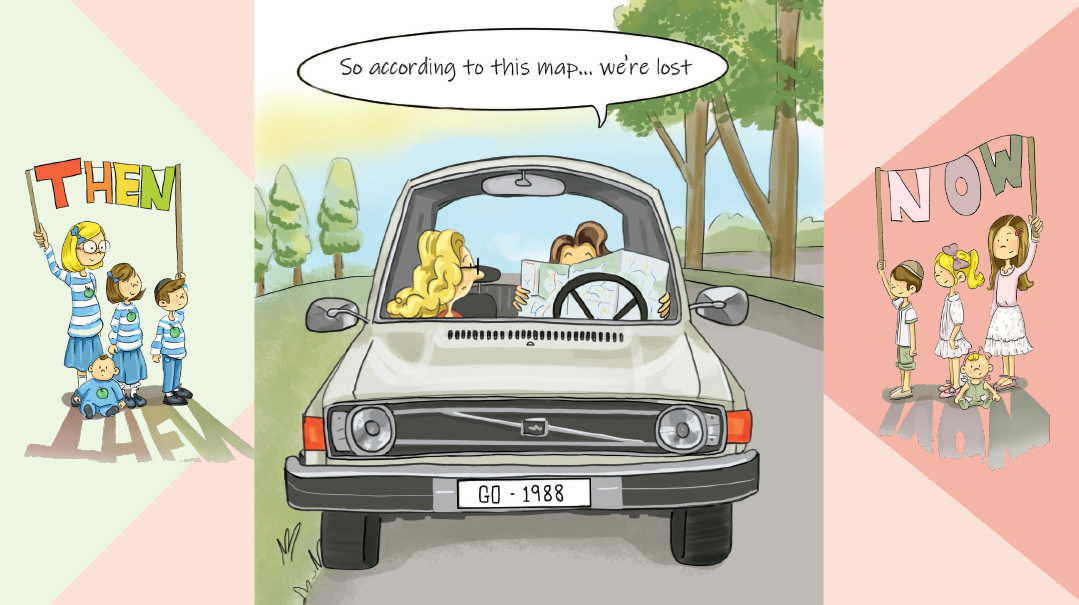One Vision: Parallel Lives
| October 2, 2007Rav Yehudah Meir Shapiro, ztz”l, and Sarah Schenirer, of blessed memory, led parallel lives, both with a vision of Kavod Shamayim.
H
ow can one person accomplish the impossible? Only with siyata d’Shmaya. Rav Wolbe, ztz”l, tells us: “Know this true, awesome fact: What a person b’eme wants, he will be able to achieve. What a person actually achieves in his life reveals what he wanted in the first place.”
The early 1900s. The pre-Holocaust destructive winds of Communism, Socialism, secular Zionism, and “The Enlightenment” were sweeping across Europe. But Hashem, Who sends the healing before the malady, sent two visionaries to create the learning networks for post-war rebuilding. Like meteorites flashing white fire across a black sky, Rav Yehudah Meir Shapiro and Sarah Schenirer transformed and established our Torah educational systems.
In honor of Rav Shapiro’s seventy-fourth yahrtzeit, let us glimpse into the heart of the man as he accepts the prestigious position of Rav of Piotrkow.
The First Mazel Tov
In the spring of 1924, the Jewish community of the major city of Piotrkow assumed a festive air. HaRav Yehudah Meir Shapiro was arriving for his inauguration ceremony as their spiritual leader. At thirty-seven, he was both the youngest and the first person from Galicia to be appointed to such an elevated position.
Amid the European pomp and circumstance, the crowd parted, and Rav Shapiro entered the shul. He approached the paroches, kissed it, and uttered the first words of his inaugural address: “Mazel tov, Mamme! Dien Meyer’ke is givorren rav in Piotrkow! — Mazel tov, Mama! Your Meir’ke has become the Rabbi of Piotrkow!”
He lifted his head in the direction of the curtained Ezras Nashim, the women’s gallery, and said, “Mazel tov to all you Jewish mothers! With great effort and self-denial, you’re bringing up your Meyer’ke, Shloimeh, or Duvid’l, and with hard work are shaping his character and personality … Who knows to what greatness you are raising him?” (Carry Me in Your Heart, Pearl Beinisch, Feldheim, 2003, p. 41).
Rav Shapiro was famed for his brilliance. Why didn’t he open his address with divrei Torah? Because no one knew better than he did that he owed everything to his mother. The foundation of who he was, who he was yet to become, and his vision of Daf Yomi came directly from his mother’s heart: “Meir’l, my child, see to it that you study well and learn Torah. Because every day that goes by with no Torah learned is something precious lost that can never be regained, and who knows what the next day may bring?” To encourage him in his diligent studies, she would say, “For such a great and mighty Torah, this is too small a sacrifice” (A Blaze in the Darkening Gloom, Rav Yehoshua Baumol, Hy”d, Feldheim, 1994, p.11).
Rav Shapiro would often say to his talmidim, repeating his mother’s words: “We have to spend time with Torah every day, by studying Daf Yomi. Because every day that goes by with no Torah learned is something precious lost that can never be regained, and who knows what the next day may bring?”
Daydreams of a Lively Genius
At age eight, Meir’l was already light years beyond his peers. The Shatzer Rav invited the boy illui to come learn with his group of fourteen-year-old talmidim.
During recess, he would play with some of his younger peers. At times, he would share his vision, which was burning brightly even then: “Wouldn’t it be amazing if somehow the whole world could be learning the same Torah at the same time?”
“Those things are for gedolim to speak about. Not little boys.”
But this little boy already had the heart as well as the mind of a future gadol. Undaunted, he held to his dream, “the way a shipwrecked man holds on to a floating board [a daf] at sea” (Yevamos 121).
His Dream Takes Root
Years later, in 1923, an ebullient Rav Meir, presented his vision at the Knessia Gedolah. Every rabbi and leader present accepted on himself to begin, from Rosh HaShanah, to learn the same daf each day.
Weeks later, Rav Meir received a letter from his sister who lived in Bukovina province: “On Rosh HaShanah night, I dreamed that I saw you in Heaven, dear brother, surrounded by a great mass of angels … all radiant as the light of the firmament. And you, my brother, were standing in their midst, your face alight like the sun in its full strength; and they were all smiling to you, as they thanked you and rejoiced with you very, very greatly … “(A Blaze in the Darkening Gloom, p. 165).
Yeshivas Chachmei Lublin
Never one to rest on his laurels, Rav Shapiro had another vision: to ease the difficult circumstances of the young boys who learned Torah, and to create a yeshivah to train future Torah leaders in Poland.
At that time in Europe, if a young man wished to continue learning Torah past cheder, he was subject to intolerable living conditions. Yeshivos didn’t have kitchens or dormitories. The boy would leave home and subject himself to what was called “essen tehg.” That meant that each day, usually for only one meal, another family in the community would take him in. Often these families had barely enough to eat, themselves. But they shared their meager fare with the boy. For sleeping accommodations, the yeshivah bochur often became a midnight watchman. In exchange for “guarding” a local shop, he could sleep on its cold, hard storefront floor.
Rav Shapiro’s dream was to restore honor to the Torah and to those who, with great sacrifice, devote their lives to its study.
Sewing Garments, Mending Souls
At the same time, a young woman sat in her seamstress shop, her soul distressed, her heart aflame: Jewish girls, even those from the best homes, were heading for universities and non-frum youth groups. The ethics of kindness, admiration of intellectual attainments, and love of Zion that they’d been raised on were twisted and perverted by teachings of Communism, Socialism, and secular Zionism.
Sarah Schenirer felt that a school system was needed to save them. Few of the leaders of the time supported her idea. Among those who did were the Chofetz Chaim, the Belzer Rebbe, and Rav Yehudah Meir Shapiro, zichronam l’vrachah. In fact, two daughters of Rabbi Yisrael Moshe Schmidt, ztz”l, mashgiach of Rav Shapiro’s Yeshivas Chachmei Lublin, were among her first pupils.
At that same Knessia Gedolah in 1923, where the Daf Yomi became reality, Agudas Yisrael acknowledged the importance of Bais Yaakov and took steps to take the organization under its strong wings. By 1924, Dr. Leo Deutschlander, Agudah’s chairman of Keren HaTorah, put his brilliance, creativity, and funding completely behind Bais Yaakov. By the time Yeshivas Chachmei Lublin was flourishing, the tiny Bais Yaakov classroom that began with seven students had blossomed into a network of 265 schools, with almost 40,000 students.
Sarah Schenirer trained an army of brilliant, devoted young women, messengers of her vision. She sent them out to establish schools in cities and far-flung hamlets all over Europe. A wellspring of ahavas Yisrael, simchah, and love of Hashem, Sarah Schenirer was also a brilliant strategist. She knew how to build a network and how to empower others; she was dedicated to spreading her knowledge and her vision, not merely trying to build her own community. A purely selfless idealist, she worked only for kavod Shamayim, totally for Hashem.
She would take her young talmidos to the shtetlach, have them speak, then ask the listeners, “Wouldn’t you like to have your daughters taught by young ladies like these?”
So critical was the work of Bais Yaakov that Rav Hamburger, a nephew of one of Sarah Schenirer’s pioneering teachers, records: “My aunt once spoke to the gaon, HaRav Meir Shapiro, ztz”l, of Lublin, and he told her, ‘If not for your work in educating Jewish daughters, I would have to close my yeshivah in Lublin!’” (Rav Hamburger, as quoted in Dei’ah v’Dibur, “Remembering Soroh Schenirer,” by Rabbi Yosef Cowen).
The Torah Is Our Homeland
The structures of Yeshivas Chachmei Lublin and the first Bais Yaakov Seminary are still standing. The Yeshivah was occupied by the Nazis during the war and later became a Polish nursing school. It was recently re-purchased by a Jewish foundation. The Seminary is now an office building.
Yet their Torah has gone forth, like the exploding sparks of the meteorite as it hurls along its course. We have a growing international community of Bais Yaakovs, cheders, yeshivos, kollels, Torah publications, kiruv organizations, and study groups. The Daf Yomi has become a daily flourishing, growing “global Har Sinai”!
Though Rav Shapiro’s yeshivah is empty, the Torah learning that he established has transcended time and space. The words that he taught his talmidim, “The Torah is our homeland; morality is our shield,” are the true living legacy that Rav Yehudah Meir Shapiro and Sarah Schenirer have given to us and coming generations.
Through the Doorway that Changes Lives: The Living Impact of Sarah Schenirer
Every Rosh Chodesh Nisan, Memphis-born Rebbetzin Chana Silver — teacher, crisis counselor, and the “Dear Chana” columnist for JemSem Website — along with participating rabbis, leads Legacy’s annual women’s trip to Poland. She shares what it means to her to bring her students to the famous five-story gray brick building on Stanislawa Street, the first Bais Yaakov Teachers Seminary, in Krakow:
It’s enthralling. Everything I do — my very life, my Bais Yaakov Torah education, that I have the privilege to teach Torah — is only because of Sarah Schenirer. And it all emanated from this place. The girls come away from these Legacy journeys with a different perspective on life — how they perceive themselves, their relationship with Torah, what kind of person they want to marry, how they’ll live, how they’ll raise the next generation.
What a tremendous and wondrous zchus to be here! Frightening, because it is an awesome responsibility to be a cog in the wheel of helping to shape the future of klal Yisrael. Each girl is a world unto herself, from whom generations will be born. When we daven at her kever, I pray that I can attain a bit of the kochos of this Mother in Israel, to be able to give over Hashem’s Word properly, to inspire, to have siyata d’Shmaya, and to live a worthwhile life, as she did. The whole of the trip, to the concentration camps and to many gravesites of tzaddikim, continues to be a moving experience for me, but these two places are certainly a highlight, affecting me in a very deep way.
From a student’s journal:
Make Every Day Count: Creating Kodak Eternal Moments
One of the many lessons I learned from Mrs. Silver’s shiur about Sarah Schenirer is how to make your moments count. Grab as many mitzvos and become the best eved Hashem that you can possibly be, because that’s what’s eternal and will be coming with you to the next world. Sara Schneirer was full of “Kodak Eternal Moments,” as Mrs. Silver calls them, always filling her moments with meaningful, eternal things.
For example, something that can take literally five seconds: Sara Schneirer would always be the first to wish her students a good morning, with a seiver panim yafos, a pleasant countenance. Another practical idea that Mrs. Silver gave us on “carpe diem” was to work on making our daily brachos more meaningful, to understand what we’re saying. Because, again, these are the moments we’ll be taking with us to Shamayim, after 120, G-d-willing.
It’s so exciting to hear the story of Sarah Schenirer’s life, in the very building where she taught, where it all started. After class, we davened Minchah there. So many of us felt like we walked out different people — more committed to living a real Torah life.
(Originally featured in Family First, Issue 61)
Oops! We could not locate your form.







